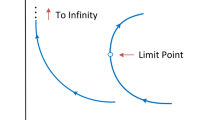Abstract
This paper presents an on-board guidance and targeting design that enables explicit state and thrust vector control and on-board targeting for planetary descent and landing. These capabilities are developed utilizing a new closed-form solution for the constant thrust arc of the braking phase of the powered descent trajectory. The key elements of proven targeting and guidance architectures, including braking and approach phase quartics, are employed. It is demonstrated that implementation of the proposed solution avoids numerical simulation iterations, thereby facilitating on-board execution of targeting procedures during the descent. It is shown that the shape of the braking phase constant thrust arc is highly dependent on initial mass and propulsion system parameters. The analytic solution process is explicit in terms of targeting and guidance parameters, while remaining generic with respect to planetary body and descent trajectory design. These features increase the feasibility of extending the proposed integrated targeting and guidance design to future cargo and robotic landing missions.









Similar content being viewed by others
References
Apollo 12 mission report, trajectory reconstruction and post-flight analysis, vol. 1, NASA-TM-x-70272, houston, TX, 1970
Azimov, D.M.: Automated, real-time targeting and guidance software for lunar-descent and precision landing. Final report. ARTGUID 2009-07-22. NASA SBIR phase I. Contract NNX09CE29p, pp. 53 (2009)
Paschall, S., Brady, T., Fill, T., Sostaric, R.: Lunar landing trajectory design for onboard hazard detection and avoidance. In: 32nd Annual AAS Guidance and Control Conference, Breckenridge, CO (2009)
Christensen, D., Geller, D.: Terrain-relative and beacon-relative navigation for lunar powered descent and landing. J. Astronaut. Sci. 58(1), 121–151 (2011)
Blackmore, L., Acikmese, B., Scharf, D.P.: Minimum-landing-error powered-descent guidance for mars landing using convex optimization. Guid. Control Dynam. 33(4), 1161–1171 (2010)
Burkhart, P.D., Casoliva, J., Balaram, B.: Mars science laboratory entry and landing simulation using DSENDS. In: Advances in the Astronautical Sciences, Spaceflight Mechanics 2013. Paper AAS 13-421, vol. 148, Part 1, pp. 583–601 (2013)
Azimov, D.M.: Extremal analytical control and guidance solutions for powered descent and landing. In: 23rd International Symposium on Space Flight Dynamics. Pasadena, CA, p. 24 (2012)
Chomel, C.T., Bishop, R.H.: An analytical lunar descent guidance algorithm. AIAA J. Guid. Control Dynam. 32(3), 915–926 (2009)
Rea, J., Bishop, R.H.: Analytical dimensional reduction of a fuel optimal powered descent subproblem. In: AIAA Guidance, Navigation, and Control Conference, AIAA-2010-8026, Toronto, Ontario (2010)
Sostaric, R.: Powered descent trajectory guidance and some considerations for human lunar landing. In: AAS Guidance and Control Conference, AAS 07-051, Breckenridge, CO (2007)
Guo, J., Han, C.: Design of guidance laws for lunar pinpoint soft landing. Advances in the Astronautical Sciences, Astrodynamics 135, 2133–2146 (2009). Paper AAS 09-431
Azimov, D.M., Bishop, R.H.: Reconstruction of apollo targeting and guidance for powered lunar descent. New Trends in Astrodynamics and Applications V, Milan, Italy (2008)
Bishop, R.H., Azimov, D.M.: Improved apollo targeting for onboard lunar landing site Re-Designation. New Trends in Astrodynamics and Applications V, Milan, Italy (2008)
Epp, C.D., Smith, T.B.: The autonomous precision landing and hazard detection and avoidance technology (ALHAT). In: Go for Lunar Landing: From Terminal Descent to Touchdown Conference, Panel 4: GNC (2008). (see Website: http://ser.sese.asu.edu/GO/)
Klumpp, A.R.: Apollo Lunar-Descent guidance, apollo guidance navigation control, R-695, MIT Instrumentation Laboratory Report, Cambridge MA (1971)
Kelley, H.J.: Guidance theory and extremal fields. IEEE Trans. Autom. Control 5(2), 75–82 (1962)
Cherry, G.W.: E-Guidance - A General explicit, optimizing guidance law for Rocket-Propelled spacecraft, R-456, MIT Instrumentation Laboratory Report, Cambridge MA (1964)
Hu, S., Thompson, T.: A Direct and Analytical Solution for Space Flight Guidance Functions. Northrop Space Laboratories, Huntsville, AL (1966)
Klumpp, A.R.: Manually retargeted automatic landing system for the lunar module (LM). AIAA J. Spacecr. Rocket. 5(2), 129–138 (1968)
Guidance system operations plan for manned LM earth orbital and lunar missions using program luminary 1c (LM131 rev. 1), section 5. Guidance equations. (rev.8), apollo guidance navigation control, R-567, MIT Instrumentation Laboratory Report, Cambridge MA, 1970
Yang, T.L.: A targeting scheme for fuel optimal rocket trajectories with applications to the LM descent braking phase, Technical Memorandum TM - 71-2014-1, Bellcomm (1971)
Lawden, D.: Optimal Trajectories for Space Navigation. Butterworths, London (1963)
Azimov, D.M., Bishop, R.H.: Optimal trajectories for space guidance. In: Annals of New York Academy of Sciences, vol. 1065, pp. 189–209, New York, NY (2005)
Azimov, D.M., Sanabria, F.A.: Extremal control and guidance solutions for orbital transfer with intermediate thrust. J. Astronaut. Sci. 62(4), 351–383 (2015)
Changsheng, G., Jianqing, L., Huajun, D.: Wuxing j., guidance method for braking phase of lunar lander. J. Spacecr. Rocket. Engineering Notes 54(2), 523–528 (2017). https://doi.org/10.2514/1.A33641
Wibben, D.R., Furfaro, R.: Terminal guidance for lunar landing and retargeting using a hybrid control strategy. J. Guid. Control Dynam. Engineering Notes 39(5), 1168–1172 (2016). https://doi.org/10.2514/1.G001411
Gerth, I., Mooij, E.: Guidance for autonomous precision landing on atmosphereless bodies. In: AIAA Guidance, Navigation, and Control Conference, AIAA Scitech Forum, AIAA 2014-0088 (2014). https://doi.org/10.2514/6.2014-0088
Ma, L., Song, Z., Shao, Z.: Fuel-optimal trajectory optimization for lunar soft landing via enhanced simultaneous dynamic optimization approach. In: 2016 IEEE Chinese Guidance, Navigation and Control Conference (CGNCC), Nanjing, China (2016). https://doi.org/10.1109/CGNCC.2016.7828797
Boltz, F.W.: Analytic solution for vertical launch into orbit. J. Astronaut. Sci. 37, 491–511 (1989)
Azimov, D.M.: Extremal analytical solutions for intermediate-thrust arcs in the newtonian field. AIAA J. Guid. Control Dynam. 33(5), 1550–1565 (2010)
Archinal, B.A., et al.: Report of the IAU/IAG/COSPAR working group on cartographic coordinates and rotational elements of the planets and satellites: 2009. Celest. Mech. Dyn. Astron. 109(2) (2011)
Acton, C.: Navigation and ancillary information facility, available online at: http://naif.jpl.nasa.gov/naif/
Acknowledgements
The authors are thankful to Alan Klumpp, the main developer of the Apollo lunar descent guidance programs, for his discussions of the general approach used in the paper, including the description of the braking phase by closed-form solutions and the use of quartics in the design of the descent trajectory.
Author information
Authors and Affiliations
Corresponding author
Rights and permissions
About this article
Cite this article
Azimov, D.M., Bishop, R.H. Integrated Targeting and Guidance for Powered Planetary Descent. J of Astronaut Sci 65, 229–259 (2018). https://doi.org/10.1007/s40295-017-0126-4
Published:
Issue Date:
DOI: https://doi.org/10.1007/s40295-017-0126-4




